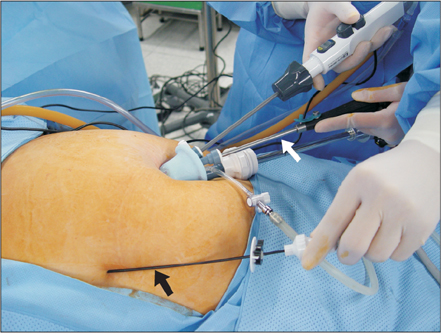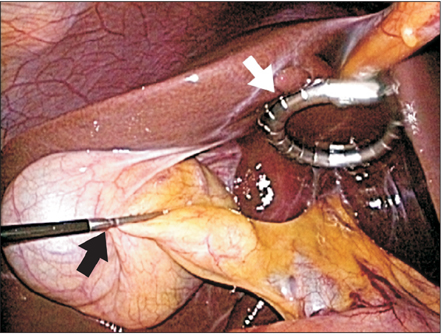Ann Surg Treat Res.
2016 Nov;91(5):233-238. 10.4174/astr.2016.91.5.233.
Single center experiences of needle-scopic grasper assisted single incision laparoscopic cholecystectomy for gallbladder benign disease: comparison with conventional 3-port laparoscopic cholecystectomy
- Affiliations
-
- 1Department of Surgery, Keimyung University Dongsan Medical Center, Keimyung University School of Medicine, Daegu, Korea.
- 2Department of Surgery, Uijeongbu St. Mary's Hospital, College of Medicine, The Catholic University of Korea, Uijeongbu, Korea. keehwan@catholic.ac.kr
- KMID: 2356373
- DOI: http://doi.org/10.4174/astr.2016.91.5.233
Abstract
- PURPOSE
Single incision laparoscopic cholecystectomy (SILC) has some technical problems. Our group has performed needlescopic grasper assisted SILC (nSILC) to overcome these problems. In this study, we introduce our technique and evaluate the safety and feasibility of this technique compared with the conventional laparoscopic cholecystectomy (CLC).
METHODS
The medical records of 485 patients who received nSILC and CLC were reviewed retrospectively. Surgical outcomes including operative time, hospital stay, postoperative pain and perioperative complication were compared between the 2 techniques.
RESULTS
Although wound complications were developed more frequently in nSILC group, there was no significant difference between groups in other surgical outcomes. In subgroup analysis, surgical outcomes of nSILC were similar with those of CLC not only in easy group but also in difficult group.
CONCLUSION
It seems that nSILC is safe and feasible not only in selected patients but also in difficult cases such as acute cholecystitis.
MeSH Terms
Figure
Cited by 1 articles
-
Comparison of postoperative pain after needle grasper-assisted single-incision laparoscopic appendectomy versus single-incision laparoscopic appendectomy: a prospective randomized controlled trial (PANASILA trial)
Byung Kwan Park, Jong Won Kim, Suk Won Suh, Joong-Min Park, Yong Gum Park
Ann Surg Treat Res. 2021;101(6):350-359. doi: 10.4174/astr.2021.101.6.350.
Reference
-
1. Solomon D, Bell RL, Duffy AJ, Roberts KE. Single-port cholecystectomy: small scar, short learning curve. Surg Endosc. 2010; 24:2954–2957.2. Pan MX, Jiang ZS, Cheng Y, Xu XP, Zhang Z, Qin JS, et al. Single-incision vs three-port laparoscopic cholecystectomy: prospective randomized study. World J Gastroenterol. 2013; 19:394–398.3. Navarra G, Pozza E, Occhionorelli S, Carcoforo P, Donini I. One-wound laparoscopic cholecystectomy. Br J Surg. 1997; 84:695.4. Wagner MJ, Kern H, Hapfelmeier A, Mehler J, Schoenberg MH. Single-port cholecystectomy versus multi-port cholecystectomy: a prospective cohort study with 222 patients. World J Surg. 2013; 37:991–998.5. Strasberg SM, Brunt LM. Rationale and use of the critical view of safety in laparoscopic cholecystectomy. J Am Coll Surg. 2010; 211:132–138.6. Avgerinos C, Kelgiorgi D, Touloumis Z, Baltatzi L, Dervenis C. One thousand laparoscopic cholecystectomies in a single surgical unit using the "critical view of safety" technique. J Gastrointest Surg. 2009; 13:498–503.7. Heistermann HP, Tobusch A, Palmes D. Prevention of bile duct injuries after laparoscopic cholecystectomy. "The critical view of safety". Zentralbl Chir. 2006; 131:460–465.8. Strasberg SM, Hertl M, Soper NJ. An analysis of the problem of biliary injury during laparoscopic cholecystectomy. J Am Coll Surg. 1995; 180:101–125.9. Yokoe M, Takada T, Strasberg SM, Solomkin JS, Mayumi T, Gomi H, et al. TG13 diagnostic criteria and severity grading of acute cholecystitis (with videos). J Hepatobiliary Pancreat Sci. 2013; 20:35–46.10. Kim MJ, Kim TS, Kim KH, An CH, Kim JS. Safety and feasibility of needlescopic grasper-assisted single-incision laparoscopic cholecystectomy in patients with acute cholecystitis: comparison with three-port laparoscopic cholecystectomy. J Laparoendosc Adv Surg Tech A. 2014; 24:523–527.11. Barband A, Fakhree MB, Kakaei F, Daryani A. Single-incision laparoscopic cholecystectomy using glove port in comparison with standard laparoscopic cholecystectomy SILC using glove port. Surg Laparosc Endosc Percutan Tech. 2012; 22:17–20.12. Cheon SU, Moon JI, Choi IS. Risk factors for prolonged operative time in single-incision laparoscopic cholecystectomy. Ann Surg Treat Res. 2015; 89:247–253.13. Srikanth G, Shetty N, Babu P. A technique for gall bladder fundal traction in single-incision laparoscopic cholecystectomy. Surg Laparosc Endosc Percutan Tech. 2011; 21:e239–e241.14. Horisberger K, Grossen E, Schöb O. How to meet the challenge of flexible exposure of the Calot triangle in SILS cholecystectomy. Surg Laparosc Endosc Percutan Tech. 2012; 22:e63–e65.15. Canes D, Desai MM, Aron M, Haber GP, Goel RK, Stein RJ, et al. Transumbilical single-port surgery: evolution and current status. Eur Urol. 2008; 54:1020–1029.16. Piskun G, Rajpal S. Transumbilical laparoscopic cholecystectomy utilizes no incisions outside the umbilicus. J Laparoendosc Adv Surg Tech A. 1999; 9:361–364.17. Raman JD, Scott DJ, Cadeddu JA. Role of magnetic anchors during laparoendoscopic single site surgery and NOTES. J Endourol. 2009; 23:781–786.
- Full Text Links
- Actions
-
Cited
- CITED
-
- Close
- Share
- Similar articles
-
- A Comparative Study of Needlescopic Grasper Assisted Single Incision versus Three Port versus Pure Single Incision Laparoscopic Cholecystectomy
- Comparison of Single-Incision Robotic Cholecystectomy, Single-Incision Laparoscopic Cholecystectomy and 3-Port Laparoscopic Cholecystectomy -Postoperative Pain, Cosmetic Outcome and Surgeon's Workload
- Current Status of Single-port Laparoscopic Cholecystectomy
- Transumbilical Laparoscopic Cholecystectomy with Additional Port: A Single Surgeon's Experience with 291 Cases
- Single Port Laparoscopic Cholecystectomy in a Patient with Situs Inversus Totalis: A Case Report



